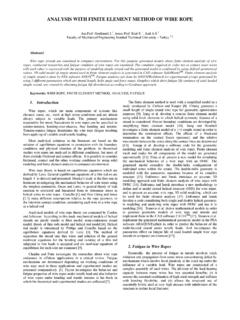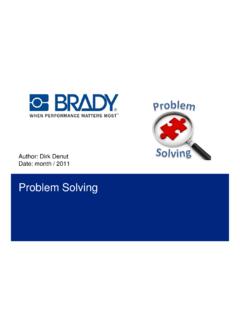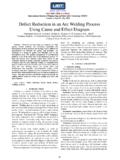Transcription of ANALYSIS OF GRINDING CRACKS CAUSES - mech-ing.com
1 CAUSE ANALYSIS OF RING BEARING GRINDING CRACKS using ishikawa DIAGRAM АНАЛИЗ НА ПРИЧИНИТЕ ЗА ПУКНАТИНИТЕ ПРИ ШЛАЙФАНЕ НА ПРЪСТЕНОВИДЕН ЛАГЕР С ИЗПОЛЗВАНЕ НА ДИАГРАМАТА "ИШИКАВА" PhD. Eng. Popa , Prof. Dr. Eng. Paraschiv , Eng. Popa , PhD. Eng. Popa , PhD. Ec. Popa , PhD. Enculescu 1 Technical University Gheorghe Asachi of Iasi-Romania, Department of Machine Manufacturing Technology, Rulmenti of Barlad-Romania Abstract: Analysing quality control tools are used for serving on the quality of data collection, processing, interpretation and use.
2 Such work tools are part of information system quality. One of these tools work available to the specialists, is the cause and effect diagram. The cause-effect diagram or the ishikawa diagram chart named also the "fishbone" has two parts: one part to another part of the cause and effect. In the preparation of these charts is recommended to use a team to ensure a better precision ANALYSIS , creating such a brainstorming session. KEY WORDS: QUALITY, CHART, BRAINSTORMING 1. Introduction ishikawa diagram is a method to systematically identify potential CAUSES .
3 The CAUSES listed above are the factors that influence the quality characteristics that it must be realized in the process (size, hardness, appearance, percentage of defective parts, ) and which normally is the effect. [1, 2, 3]. Pruteanu [4] illustrates the cases that can be classified according to their importance in major CAUSES , CAUSES secondary, tertiary, , On different levels of importance, similarity graphic representation of a skeleton is over. In the figure below we present a schematic representation of the connection that can exist between cause and effect: Fig.
4 1. Schematic representation of the causal link effect [4] 2. Types of cause and effect diagram ( ishikawa ) In practice quality control were imposed on various types of ishikawa diagrams, which differ in the structure, how to organize and systematize the CAUSES , or purposes for which uses diagrams. According to Gramescu [1] we present the following classification of diagrams: - Charts structured component of the process - that can be use for analysing dispersion characteristics of quality structured stages, steps, operations, phases, activities, sequences of the classification process for production processes.
5 These charts are grouped CAUSES major system component technology in the general case on the "6 M". Each of these categories of cases can be operated in one or more secondary diagrams characterized by a greater detail. Key benefit of this type of diagram is that deviations of the dispersion behaviour as characteristic of various CAUSES help in the systematic and relationship factors dispersion. A representation of this type of diagram we have represented in Figure 2: Diagram structured component of the process [2] Structured chart on stages of the process - are used for classification of production processes.
6 This type of diagram (arrow) follows the classification of the main production processes and all CAUSES that can affect accuracy is attached properly stage of the process, operations, those phases. As dispersion characteristic as occurs during the production process, must go through each stage of the process to detect cases. Key benefit of this type of diagram is that, giving the sequence of stages, phases, stages are easy to prepare and process it. A shortcoming, however important, is that a number of similar cases occurring several times and that the cases corresponding combination of several factors are difficult to represent.
7 Representation of a diagrams of cup type of diagram you found in Figure 3: Structured chart on stages of the process [2, 3] 26 - Structural diagrams - these charts are reduced to a list which lists all possible CAUSES . For this purpose it is necessary to make data collection from all staff involved in the process of manufacturing the product. It is good that these cases be identified and then organized, indicating which is the connection between cause and effect - evidencing feature of the product, thus obtaining a real ishikawa diagram, it can resemble the dispersion ANALYSIS .
8 The advantage of this type of diagram is that it is not neglected any possible cause. In order to draw such diagrams is difficult reference to secondary CAUSES , so that may be difficult to build. 3. Ways of preparation of charts ishikawa Drawing up a chart of this, ishikawa , it is not a simple problem. For its preparation to be as conclusive Gramescu [4] shows that it is necessary to establish clearly who is objective ANALYSIS , concluding effect and then begins to identify the CAUSES that produce it.
9 A special importance at the elaboration of such diagrams is to apart clearly the cases of corrective measures implemented. It was noted that there are several ways of drawing diagrams ishikawa . If found, after collection, as there is variation depending on the quality characteristics of a particular case, there must be a question regarding the existence, that is a variation of the effect, that the quality characteristic is created by variation of factors - CAUSES , which lead.
10 The methodology for drawing structured diagrams component of our process is Tarau proposed by [2] and consists of the following steps: It establishes quality characteristics that we want to improve or keep it under control. To eliminate the defects, you must identify the CAUSES ; - The feature writing as to the right side of a sheet of paper and is framed in a rectangle; - Plot the main line from the left to the right, the arrow can be doubled; - It says, in succession, the main reasons (which may be in the 5 "M") and that influence quality characteristics.







